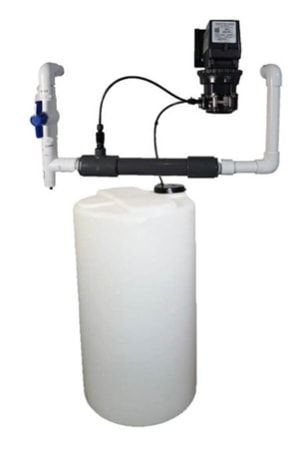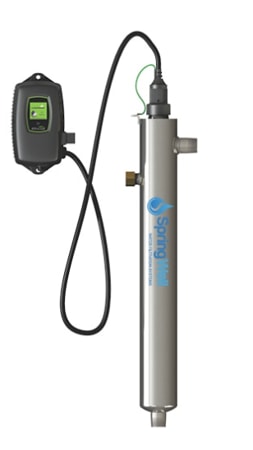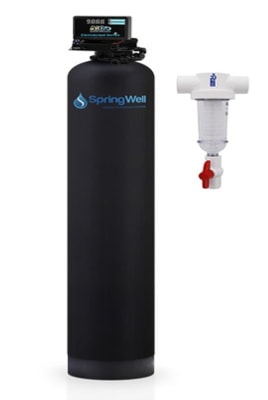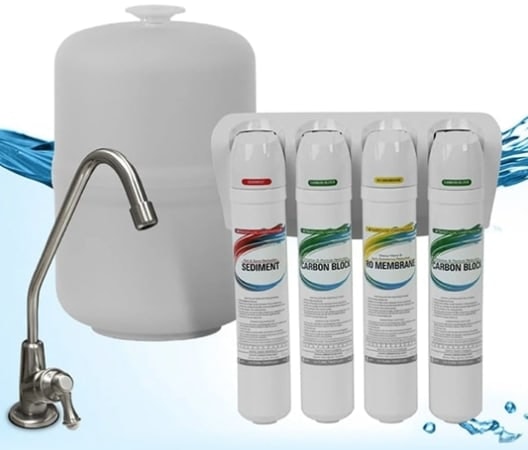Just a pro Tip: Get your well water tested before opting for a treatment method. It is possible that you may need an altogether different filter than what you are planning to install.
1. Disinfection
Disinfection kills bacteria, viruses, and other microorganisms in the well water. It is done via two ways; shock chlorination or using a chlorinator. Shock chlorination is one time measure that is done after 1-3 years while chlorinator is best for wells with recurrent bacterial contamination.
Disinfection uses chlorine to kill microorganisms in water. The only drawback for disinfection is chlorine taste and smell in water. You can install a carbon filter to remove chlorine smell & taste from water.
Recommended Chlorinator: SpringWell’s Chemical Injection System

Private wells with recurrent bacterial contamination need regular disinfection. SpringWell’s system measures water passing through it and injects metered amount of chlorine. The water leaving the unit is free from microorganisms but rich in chlorine. The excessive chlorine is filtered using a carbon filter.
The filter also oxidizes iron, sulfur, and manganese that may be present in water. The unit is easy to install, comes with a lifetime warranty, and a control head for hassle-free management.
2. UV Purification Systems
UV purification is a hassle-free way to treat well water for microorganisms. UV purifiers expose well water to UV light that destroys a microorganism’s ability to reproduce inside the host. A UV purification system doesn’t need frequent maintenance but requires UV bulb replacement every 6-12 months.
A UV purifier requires a sediment filter because UV light can’t treat water rich in sediment. UV purifiers are better than chlorinators because they don’t add smell or taste to water.
Recommended UV Purification System: SpringWell’s UV Purification System

SpringWell’s UV purification system kills up to 99.9% of viruses, bacteria, and other pathogens in water. The unit has a digital control head to manage the system and large in/out connections to maintain a good flow rate.
The electric monitor displays the UV bulb status, helping you in the upkeep of the unit. Please note that it is a costly unit and doesn’t come with a sediment filter.
3. Water Filters
Water filters come in different shapes and sizes. Common well water filters are whole house filters, under sink filters, faucet filters, acid neutralizers, and water softeners. Water softeners don’t purify water but make it fit for daily use.
Recommended Whole House Water Filter for Well Water: SpringWell’s Whole House Well Water Filter System

SpringWell’s well water filter system is perfect for a private well system. The filter can remove iron (7 PPM), hydrogen sulfide (8 PPM), and manganese (1 PPM). The filter comes with a control head for hassle-free management, a sediment filter, and a lifetime warranty.
You can easily customize the system by adding a UV, RO, or salt-based water softener.
Recommended Under Sink Filter for Well Water: SpringWell’s Reverse Osmosis Drinking System

RO filters are best for purifying drinking water. SprinmgWell’s RO system consists of a sediment filter, two carbon filters, and an RO membrane. The system has a75 gallons daily filtration capacity and can remove 99% of all contaminants in well water.
You can modify the filter to add a whole house filter or a UV purification system. One good thing about this filter is you can increase the number of taps in the system.
4. Boiling
Boiling is not an ideal solution to purify well water but it is better to drink boiled water than untreated water. Boiling kills microorganisms and removes contaminants that have a lower boiling point than water. Boiling is a time consuming job and increases energy bills. You must boil water for at least 1-2 minutes after it start bubbling.
5. Water Distillation
Distillation captures water vapors rising during boiling. The distilled water is 100% pure H20 and if often used for medical purposes. It has a bland taste that you may not find very tasty.
Other Similar Guides:
- How to Remove Calcium from Well Water?
- What is Sediment in Well Water and How to Remove it?
- How to Remove Sodium from Well Water?
- How to Test and Remove Nitrates from Well Water?
- How to Remove Iron, Manganese, Sulfur & Coliform from Well Water?
Reasons for Well Water Contamination
- Well water is contaminated when water moves underground. It can take up impurities like heavy metals, bacteria, and other contaminants in the ground.
- Improperly located well; near to septic tank, fertilizers, and petroleum storage sites.
- Volatile organic compounds (VOCs) can reach your wells due to industrial contamination and fuel drilling activities nearby.
- Waste discharge from factories, mining sites, dumping sites, mishandled waste, animal feces can also contaminate well water.
- Poor septic tanks, faulty sewer systems, trash cans can also cause water pollution. Make sure your septic tanks are located at least 50 feet from the well.
Tips to Protect your Well and Water Quality
- Always keep your well closed with a well cap or sanitary seal. It will keep animals, insects, tree debris away, and avoid unauthorized use.
- Periodically inspect the outer parts of the well for missing well caps and cracked or rusted well casing.
- Make sure there is no surface runoff near your well. You can achieve this by sloping the area near the well.
- You must install the septic tank at least 50 feet, keep livestock 50 feet away. Store petroleum tanks, pesticides, and insecticides at least 100 feet and manure stacks at least 250 feet away from your well.
- Get your well water tested regularly after 6-8 months.
- Hire a professional driller to construct a new well, modification, deepening, or any alteration for your well. If you are doing it yourself, you must take professional advice before starting the work.
- Do not mix harmful chemicals like fertilizers, pesticides, and insecticides near the well.
- Do not keep trash cans near your well or dispose of the waste materials in empty or abandoned wells.
- Ensure that all the components of your well water system, such as pump, storage tank, filters, and softeners, are working in mint condition.
Final Words
Well water is excellent and free to use sources of water. Along with impurities, it also contains all the healthy minerals required by the body. When treated carefully and according to the nature of the water, it can prove fruitful to you and your family.
